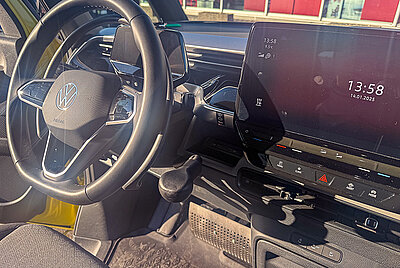Electromobility with a disability
opportunities and challenges
Sustainable mobility is becoming increasingly important - also for people with disabilities. Many PARAVAN customers want to travel in an environmentally friendly and CO₂-neutral way. But how accessible is electromobility really? The story of Dorothee, who deliberately opted for an electric vehicle, shows that there are certainly opportunities, but also challenges.
With a beaming smile, Dorothee picks up her new VW ID.Buzz at the PARAVAN branch in Heidelberg - a big step towards self-determined mobility! The journalist deliberately chose an electric vehicle. Sustainability and future-proofing were the decisive criteria for her. "I believe that the internal combustion engine is on its way out," she says. "We were looking for a car that would be with us for the next ten to 15 years and that would have a reliable range."
In the 1990s, she was diagnosed with multiple sclerosis, which over time has affected her mobility. Since 2017, she has been using an electric wheelchair. In everyday life, she prefers public transport, but for her job with many appointments outside the office, her own car is essential.
Customization for maximum mobility
A reliable range of at least 300 kilometers and enough space for her wheelchair and luggage were important criteria for her choice of vehicle. She can charge her car at a nearby charging station with an accessible infrastructure - a practical solution for when she is out and about. "I can combine it well when I go shopping," she says. "The battery is charged in 30 minutes." But she sees room for improvement: "The accessible charging infrastructure can be improved." There is currently no charging point in her underground car park.
To keep Dorothee mobile in the long term, her VW ID.Buzz was customized. The biggest challenge was getting in. "I can still get in by myself, but the height-adjustable sliding board gives me extra security. Her wheelchair is stowed behind the driver's seat with a Rausch loading aid - without having to fold it up. She steers the vehicle with the accelerator and brake levers. The ID.Buzz is already equipped with many assistance systems and extras that make driving easier and offer a significant increase in safety for drivers with disabilities.
Challenges in the conversion of electric vehicles
Converting electric vehicles poses special challenges for both PARAVAN mobility experts and users. The vehicle floor, where the battery is installed, makes it difficult or impossible to install a cassette lift. In addition, many electric vehicles do not have the necessary ground clearance or headroom. Another problem is the weight of the vehicle. Especially for larger models, such as minibuses or minivans, converters can reach the 3.5 ton payload limit. If a cassette lift, the Space Drive drive and steering system, or a transfer console is installed and an electric wheelchair is also on board, this limit can quickly be exceeded.
A possible solution would be a regulation similar to the one that will apply to commercial vehicles with alternative drive systems (electric, hydrogen) starting in 2019: holders of a B driver's license may drive vehicles with a gross vehicle weight of up to 4.25 tons (§ 6 of the German Driving License Regulation, FeV). The European Union is now planning to extend the category B driver's license for vehicles with alternative drive systems to a total weight of up to 4.25 tons. This change is intended to take into account the additional weight of batteries in electric vehicles. The proposal has already been supported by the majority of EU member states. Such a regulation would make it much easier for people with disabilities to adapt electric vehicles.
Another issue that needs to be addressed is the accessibility of the charging infrastructure. However, electric vehicles are already an interesting and contemporary alternative for drivers who can still transfer independently from a wheelchair.
"For me, mobility means first and foremost the freedom to get where I want to go - wherever the train doesn't go," says Dorothee. Her carbon footprint plays an important role for her: "I want to travel as sustainably as possible."








